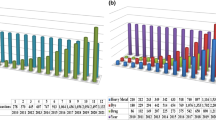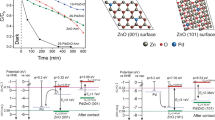Abstract
This work presents a follow-up research of our previously published work. Herein, the photocatalytic performance of a nanostructured CdZnO/NiCdO composite photoanode has been improved by intercalation of Cu catalyst atoms in the electron barrier layer of NiyCd1−yO surface by an ion exchange process. As a result, the photocurrent yield increased by 29 % at +1 V potential against Ag/AgCl. This phenomenon was tentatively attributed to the increased electron concentration and/or interaction of the Cu3d electrons with the mid-energy valence electrons. To the contrary, the introduction of Ag, Co, and Ni deteriorated the photocatalytic performance. The corrosion challenges were assessed during 50 cycles of voltammetry. The background of the degradation/photocorrosion was studied with SEM, EDX, and XPS analysis. To combat the photocorrosion, the photoanodes were coated with TiO2 protective nanolayers of different thickness. The results for the photocurrent stability at a constant potential of +1 V showed that 9 nm TiO2 coating improved the durability of the photoanode on account of a photocurrent decrease for about 50 %. XPS studies proved that the degradation/corrosion changes on the photoanode’s surface could be associated with an irreversible electrochemical oxidation of CdO into CdO2.








Similar content being viewed by others
References
Fujishima A, Honda K (1972) Electrochemical photolysis of water at a semiconductor electrode. Nature 238:37–38
Park Y, McDonald KJ, Choi KS (2013) Progress in bismuth vanadate photoanodes for use in solar water oxidation. Chem Soc Rev 42:2321–2337
Kim TW, Choi K-S (2014) Nanoporous BiVO4 photoanodes with dual-layer oxygen evolution catalysts for solar water splitting. Science 343:990–994
Wang G, Ling Y, Wang H, Xihong L, Li Y (2014) Chemically modified nanostructures for photoelectrochemical water splitting. J Photochem Photobiol C 19:35–51
Qiu Y, Leung S-F, Zhang Q, Hua B, Lin Q, Wei Z, Tsui K-H, Zhang Y, Yang S, Fan Z (2014) Efficient photoelectrochemical water splitting with ultrathin films of hematite on three-dimensional nanophotonic structures. Nano Lett 14:2123–2129
Li X, Wang Z, Zhang Z, Chen L, Cheng J, Ni W, Wang B, Xie E (2015) Light illuminated α−Fe2O3/Pt nanoparticles as water activation agent for photoelectrochemical water splitting. Sci Rep 5:9130
Kargar A, Partokia SS, Niu MT, Allameh P, Yang M, May S, Cheung JS, Sun K, Xu K, Wang D (2014) Solution-grown 3D Cu2O networks for efficient solar water splitting. Nanotechnology 25:205401
Yang J, Walczak K, Anzenberg E, Toma FM, Yuan G, Beeman J, Schwartzberg A, Lin Y, Hettick M, Javey A, Ager JW, Yano J, Frei H, Sharp ID (2014) Efficient and sustained photoelectrochemical water oxidation by cobalt oxide/silicon photoanodes with nanotextured interfaces. J Am Chem Soc 136:6191–6194
Tong X, Yang P, Wang Y, Qin Y, Guo X (2014) Enhanced photoelectrochemical water splitting performance of TiO2 an ultrathin nitrogen-doped carbon molecular layer deposition. Nanoscale 6:6692–6700
Brillet J, Yum J-H, Cornuz M, Hisatomi T, Solarska R, Auguastynski J, Graetzel M, Sivula K (2012) Highly efficient water splitting by a dual-absorber tandem cell. Nat Photonics 6:824–828
Arthur RM, Nozik J (1996) Physical chemistry of semiconductor-liquid interfaces. J Phys Chem 100:13061–13078
Deutsch TG, Koval CA, Turner JA (2006) III-V nitride epilayers for photoelectrochemical water splitting: GaPN and GaAsPN. J Phys Chem B 110:25297–25307
Bak T, Nowotny J, Rekas M, Sorrell CC (2002) Photo-electrochemical hydrogen generation from water using solar energy; materials-related aspects. Int J Hydrog Energy 27:991–1022
Burstein GA (2005) Century of Tafel’s equation: 1905–2005 a commemorative issue of corrosion science. Corros Sci 47:2858–2870
Maeda K, Takata T, Hara M, Saito N, Inoue Y, Kobayashi H, Domen K (2005) GaN:ZnO solid solution as a photocatalyst for visible-light-driven overall water splitting. J Am Chem Soc 127:8286–8287
Trunk M, Gorzkowska-Sobas A, Venkatachalapathy V, Zhang T, Galeckas A, Kuznetsov AY (2012) Novel ZnO-based ternary oxides for optoelectronic applications. Energy Procedia 22:101–107
Detert DM, Lim SHM, Tom K, Luce AV, Anders A, Dubon OD, You KM, Walukiewicz W (2013) Crystal structure and properties of Cd1-xZnxO alloys across the full composition range. App Phys Lett 102:232103–232104
Detert DM, Tom KB, Battaglia C, Denlinger DJ, Lim SHN, Javey A, Anders A, Dubon OD, Yu KM, Walukiewicz W (2014) Fermi level stabilization and band edge energies in CdxZn1−xO alloys. J App Phys 115:233708–233706
Francis CA, Detert DM, Chen G, Dubon OD, KM Y, Walukiewicz W (2015) NixCd1-xO: semiconducting alloys with extreme type III band offsets. App. Phys Lett 106:022110–022114
Ristova MM, Zhu W, KM Y, Walukiewicz W (2016) Semiempirical modeling of a three sublayer photoanode for highly efficient photoelectrochemical water splitting: parameter and electrolyte optimizations. Sol Energy Mat Sol Cells 157:190–199
Chen S, Wang-Wang L (2012) Thermodynamic oxidation and reduction potentials of photocatalitic semiconductors in aqueous solution. Chem Mater 24:3659–3666
Domenech J, Prieto A (1986) Stability of ZnO particles in aqueous suspensions under UV illumination. J Phys Chem 90:1123–1126
Ristova M, Velevska J, Ristov M (2002) Chemical bath deposition and electrochromic properties of NiOx films. Sol Energy Mat Sol Cells 71:219–230
Pauling L (1967) The chemical bond. Cornell University Press, Ithaca, New York
Shen ZX, List RS, Dessau DS, Wells BO, Jepsen O, Arko AJ, Barttlet R, Shih CK, Parmigiani F, Huang JC, Lindberg PAP (1991) Electronic structure of NiO: correlation and band effects. Phys Rev B 44
King PDC, Veal TD, Schleife A, Zuniga-Perez J, Martel B, Jefferson PH, Fuchs F, Munoz-Sanjose V, Bechstedt F, McConville CF (2009) Valence-band electronic structure of CdO, ZnO, and MgO from x-ray photoemission spectroscopy and quasi-particle-corrected density-functional theory calculations. Phys Rev B 79:205205
Ristova TP, Mitreski M, Ristov M (1998) Silver doping of thin CdS films by an ion exchange process. Thin Solid Films 315:301–304
Takahashi T, Nomura E, Yamamoto O (1973) Solid state ionics—the ionic conductivity of the Ag2S-Ag1.70Te-AgX system (AgX; Ag4P2O7, Ag3PO4and AgPO3. J Appl Electrochem 3:23–29
Matienzo LJ, Yin LI, Grim SO, Swartz WE Jr (1973) X-ray photoelectron spectroscopy of nickel compounds. Inorg Chem 12:2762–2769
Khallaf H, Chen C-T, Chang L-B, Lupan O, Dutta A, Heinrich H, Shenouda A, Chow L (2011) Investigation of chemical bath deposition of CdO thin films, using three different complexing agents. Appl Surf Sci 257:9237–9242
Liu H, Mao H, Somayazulu M, Ding Y, Meng Y, Hausermann D (2004) B 1-to-B 2 phase transition of transition-metal monoxide CdO under strong compression. Phys Rev B 70:094114
Wriedt HA (1987) The Cd−O (cadmium-oxygen) system. Journal of Phase Equilibria 8:140–147
Ristova MM, Gligorova A, Nasov I, Gracin D, Milun M, Kostadinova-Boskova K, Popeski-Dimovski R (2012) TiO2 coating for SnO2:F films produced by filtered cathodic arc evaporation for improved resistance to H+ radical exposure. J Electron Mater 41
Gu K, Zhong P, Guo M, Ma J, Jiang Q, Zhang S, Zhou X, Xie Y, Ma X, Wang Y (2016) Sonication-polished anodic TiO2 nanotube array-based photoanode for efficient solar energy conversion. J Solid State Electrochem DOI. doi:10.1007/s10008-016-3301-9
Zhonga P, Ma X, Chen X, Zhong R, Liu X, Ma D, Zhang M, Li Z (2015) Morphology-controllable polycrystalline TiO2 nanorod arrays for efficient charge collection in dye-sensitized solar cells. Nano Energy 16:99–111
Jang JS, Ji SM, Bae SW, Son HC, Lee JS (2007) Optimization of CdS/TiO2 nano-bulk composite photocatalysts for hydrogen production from Na2S/Na2SO3 aqueous electrolyte solution under visible light (λ ≥ 420 nm. J Photochem Photobiol A 188(1):112–119
Walukiewicz W, Detert D, Yu KM, Ristova M (2015) U.S. non-provisional patent application. Attorney Docket No:S-135–S-383
Ristova MM, Francis C, Toma FM, Yu KM, Walukiewicz W (2016), Electrochemical modification of the optical and electrical properties of Cd-rich NixCd1–xO alloys. Sol energy mat Sol Cells 147:127–133.
Acknowledgments
This work was performed at the EMAT, LBNL and was supported by the Director, Office of Science, Office of Basic Energy Sciences, Materials Sciences, and Engineering Division of the U.S. Department of Energy under Contract No. DE-AC02-05CH11231. Dr. Ristova kindly expresses her gratitude to the Fulbright Visiting Scholar Program at the US Department of State for supporting her stay/research at the Lawrence Berkeley National Laboratory, Grant No. 68130116 during entire 2014. We kindly thank Wei Zhu for RF sputtering of the profiles, Francesca M. Toma for the XPS spectra and Douglas Detert for our fruitful discussions, all affiliated to LBNL 2014.
Author information
Authors and Affiliations
Corresponding author
Rights and permissions
About this article
Cite this article
Ristova, M.M., Yu, K.M. Surface modification of NiCdO barrier layer in complex photoanodes and TiO2 protective coating for efficient and stabile water dissociation. J Solid State Electrochem 21, 803–812 (2017). https://doi.org/10.1007/s10008-016-3398-x
Received:
Revised:
Accepted:
Published:
Issue Date:
DOI: https://doi.org/10.1007/s10008-016-3398-x




